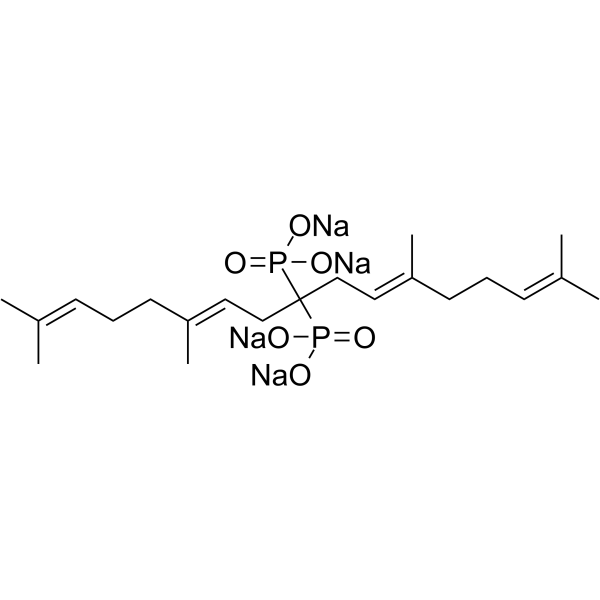Digeranyl bisphosphonate (Synonyms: DGBP) |
| カタログ番号GC65270 |
ジゲラニル ビスホスホネート (DGBP) は、Rac1 のゲラニルゲラニル化を阻害する強力なゲラニルゲラニルピロリン酸 (GGPP) シンターゼ阻害剤です。
Products are for research use only. Not for human use. We do not sell to patients.

Cas No.: 878143-03-4
Sample solution is provided at 25 µL, 10mM.
Digeranyl bisphosphonate (DGBP) is a potent geranylgeranylpyrophosphate (GGPP) synthase inhibitor, which inhibits geranylgeranylation of Rac1.
Digeranyl bisphosphonate (DGBP) impairs geranylgeranylation. To examine if Digeranyl bisphosphonate modulates Rac1 activity, cells are exposed to vehicle or Digeranyl bisphosphonate. Rac1 activation increases significantly after chrysotile exposure, whereas the activity in Digeranyl bisphosphonate -treated cells is reduced to control levels. Digeranyl bisphosphonate also decreases H2O2 generation in chrysotile-exposed macrophages[1].
To further evaluate the effect of Digeranyl bisphosphonate (DGBP; 0.2 mg/kg/day) in protecting mice from chrysotile-induced pulmonary fibrosis, the mice are administered vehicle or Digeranyl bisphosphonate subcutaneously in osmotic pumps, and exposed to saline or chrysotile the following day. Mice exposed to saline have normal lung architecture with vehicle and Digeranyl bisphosphonate treatment. Chrysotile-exposed mice that receive vehicle have significant architectural changes in their lung parenchyma and large amounts of collagen deposition, whereas the lungs of the Digeranyl bisphosphonate -treated mice are essentially normal. To investigate the effect of Digeranyl bisphosphonate in Bleomycin-induced fibrosis, osmotic pumps containing either vehicle or Digeranyl bisphosphonate are implanted subcutaneously in WT mice. Mice are exposed to saline or Bleomycin the following day. Digeranyl bisphophonate (0.2 mg/kg/day)-treated mice show significantly less hydroxyproline compared to vehicle-treated mice exposed to Bleomycin[1].
[1]. Osborn-Heaford HL, et al. Targeting the isoprenoid pathway to abrogate progression of pulmonary fibrosis. Free Radic Biol Med. 2015 Sep;86:47-56.
Average Rating: 5 (Based on Reviews and 30 reference(s) in Google Scholar.)
GLPBIO products are for RESEARCH USE ONLY. Please make sure your review or question is research based.
Required fields are marked with *




















